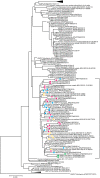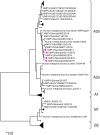Consensus and variations in cell line specificity among human metapneumovirus strains
- PMID: 31013314
- PMCID: PMC6478314
- DOI: 10.1371/journal.pone.0215822
Consensus and variations in cell line specificity among human metapneumovirus strains
Abstract
Human metapneumovirus (HMPV) has been a notable etiological agent of acute respiratory infection in humans, but it was not discovered until 2001, because HMPV replicates only in a limited number of cell lines and the cytopathic effect (CPE) is often mild. To promote the study of HMPV, several groups have generated green fluorescent protein (GFP)-expressing recombinant HMPV strains (HMPVGFP). However, the growing evidence has complicated the understanding of cell line specificity of HMPV, because it seems to vary notably among HMPV strains. In addition, unique A2b clade HMPV strains with a 180-nucleotide duplication in the G gene (HMPV A2b180nt-dup strains) have recently been detected. In this study, we re-evaluated and compared the cell line specificity of clinical isolates of HMPV strains, including the novel HMPV A2b180nt-dup strains, and six recombinant HMPVGFP strains, including the newly generated recombinant HMPV A2b180nt-dup strain, MG0256-EGFP. Our data demonstrate that VeroE6 and LLC-MK2 cells generally showed the highest infectivity with any clinical isolates and recombinant HMPVGFP strains. Other human-derived cell lines (BEAS-2B, A549, HEK293, MNT-1, and HeLa cells) showed certain levels of infectivity with HMPV, but these were significantly lower than those of VeroE6 and LLC-MK2 cells. Also, the infectivity in these suboptimal cell lines varied greatly among HMPV strains. The variations were not directly related to HMPV genotypes, cell lines used for isolation and propagation, specific genome mutations, or nucleotide duplications in the G gene. Thus, these variations in suboptimal cell lines are likely intrinsic to particular HMPV strains.
Conflict of interest statement
The authors have declared that no competing interests exist.
Figures






Similar articles
-
Predominant Detection of the Subgroup A2b Human Metapneumovirus Strain with a 111-Nucleotide Duplication in the G gene in Yokohama City, Japan in 2018.Jpn J Infect Dis. 2019 Sep 19;72(5):350-352. doi: 10.7883/yoken.JJID.2019.124. Epub 2019 May 31. Jpn J Infect Dis. 2019. PMID: 31155603
-
Efficient isolation of human metapneumovirus using MNT-1, a human malignant melanoma cell line with early and distinct cytopathic effects.Microbiol Immunol. 2017 Nov;61(11):497-506. doi: 10.1111/1348-0421.12542. Microbiol Immunol. 2017. PMID: 28940687
-
180-Nucleotide Duplication in the G Gene of Human metapneumovirus A2b Subgroup Strains Circulating in Yokohama City, Japan, since 2014.Front Microbiol. 2017 Mar 14;8:402. doi: 10.3389/fmicb.2017.00402. eCollection 2017. Front Microbiol. 2017. PMID: 28352258 Free PMC article.
-
[Human Metapneumovirus in hospitalized children - a review].Klin Padiatr. 2007 Mar-Apr;219(2):58-65. doi: 10.1055/s-2006-921344. Epub 2006 Mar 1. Klin Padiatr. 2007. PMID: 16586267 Review. German.
-
[Human metapneumovirus].Uirusu. 2006 Dec;56(2):173-81. doi: 10.2222/jsv.56.173. Uirusu. 2006. PMID: 17446666 Review. Japanese.
Cited by
-
The furin cleavage site in the SARS-CoV-2 spike protein is required for transmission in ferrets.Nat Microbiol. 2021 Jul;6(7):899-909. doi: 10.1038/s41564-021-00908-w. Epub 2021 Apr 27. Nat Microbiol. 2021. PMID: 33907312
-
Recent Molecular Evolution of Human Metapneumovirus (HMPV): Subdivision of HMPV A2b Strains.Microorganisms. 2020 Aug 21;8(9):1280. doi: 10.3390/microorganisms8091280. Microorganisms. 2020. PMID: 32839394 Free PMC article.
-
Inactivation Activities of Ozonated Water, Slightly Acidic Electrolyzed Water and Ethanol against SARS-CoV-2.Molecules. 2021 Sep 8;26(18):5465. doi: 10.3390/molecules26185465. Molecules. 2021. PMID: 34576934 Free PMC article.
-
Essential role of TMPRSS2 in SARS-CoV-2 infection in murine airways.Nat Commun. 2022 Oct 15;13(1):6100. doi: 10.1038/s41467-022-33911-8. Nat Commun. 2022. PMID: 36243815 Free PMC article.
-
Mefloquine, a Potent Anti-severe Acute Respiratory Syndrome-Related Coronavirus 2 (SARS-CoV-2) Drug as an Entry Inhibitor in vitro.Front Microbiol. 2021 Apr 30;12:651403. doi: 10.3389/fmicb.2021.651403. eCollection 2021. Front Microbiol. 2021. PMID: 33995308 Free PMC article.
References
-
- Boivin G, Abed Y, Pelletier G, Ruel L, Moisan D, Cote S, et al. Virological features and clinical manifestations associated with human metapneumovirus: a new paramyxovirus responsible for acute respiratory-tract infections in all age groups. J Infect Dis. 2002;186(9):1330–4. 10.1086/344319 . - DOI - PubMed
-
- Biacchesi S, Skiadopoulos MH, Boivin G, Hanson CT, Murphy BR, Collins PL, et al. Genetic diversity between human metapneumovirus subgroups. Virology. 2003;315(1):1–9. Epub 2003/11/01. . - PubMed
Publication types
MeSH terms
Substances
LinkOut - more resources
Full Text Sources
Other Literature Sources
Research Materials
Miscellaneous

